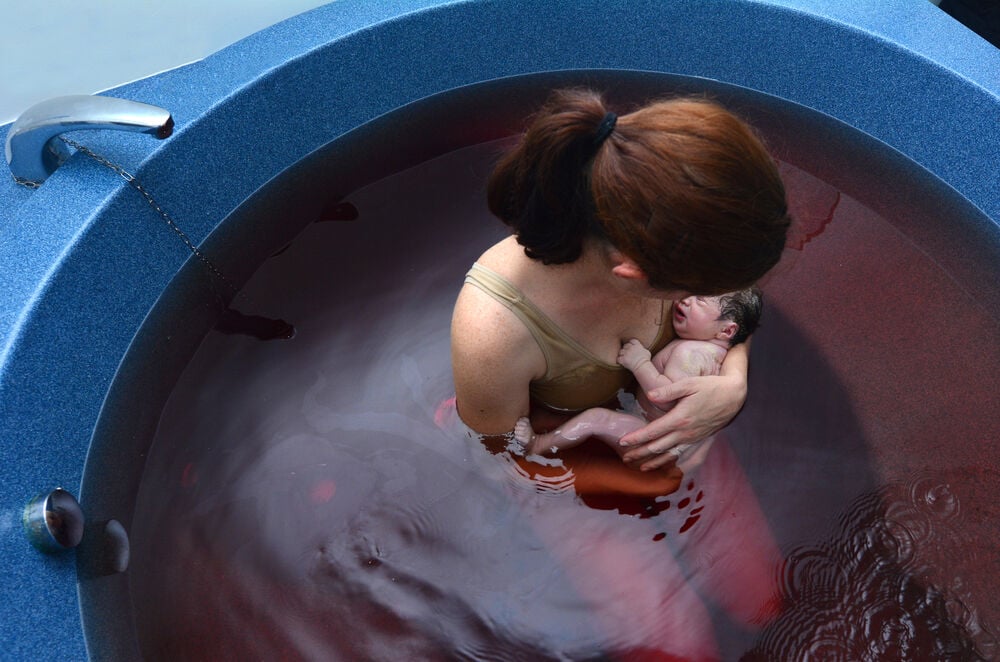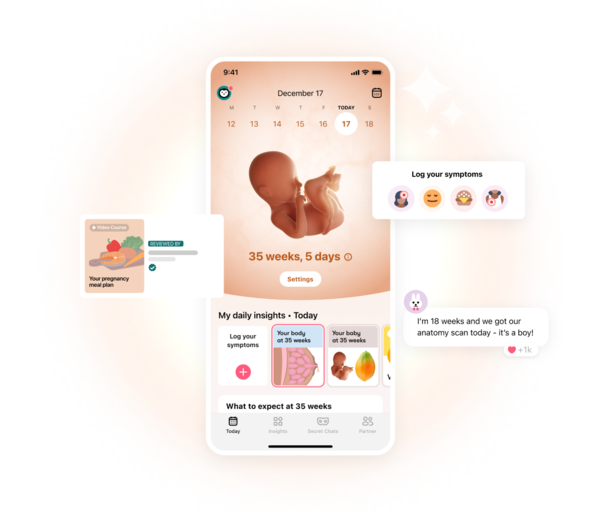Following the resurgence of natural, unmedicated labor and delivery trends, many hospitals and birthing centers now offer the option of water birth. A water birth can be a very normal part of the labor and delivery process. Many women claim that it is the reason they were able to have the unmedicated birth they had dreamed of.
-
Tracking cycle
-
Getting pregnant
-
Pregnancy
-
Help Center
-
Flo for Partners
-
Anonymous Mode
-
Flo app reviews
-
Flo Premium New
-
Secret Chats New
-
Symptom Checker New
-
Your cycle
-
Health 360°
-
Getting pregnant
-
Pregnancy
-
Being a mom
-
LGBTQ+
-
Quizzes
-
Ovulation calculator
-
hCG calculator
-
Pregnancy test calculator
-
Menstrual cycle calculator
-
Period calculator
-
Implantation calculator
-
Pregnancy weeks to months calculator
-
Pregnancy due date calculator
-
IVF and FET due date calculator
-
Due date calculator by ultrasound
-
Medical Affairs
-
Science & Research
-
Pass It On Project New
-
Privacy Portal
-
Press Center
-
Flo Accuracy
-
Careers
-
Contact Us
Water Birthing in Hospitals: Everything You Need to Know


Every piece of content at Flo Health adheres to the highest editorial standards for language, style, and medical accuracy. To learn what we do to deliver the best health and lifestyle insights to you, check out our content review principles.
Water immersion in labor and water birth refers to a birth process in which part (or all) of the labor and delivery occurs in a birthing pool. Water births may take place at home, in a birthing center, or in a hospital. A pregnant woman who wishes to try water labor or water birthing can be cared for by an obstetrician, a certified nurse-midwife, or a midwife.
The scopes of practice vary for different providers and the rules and laws related to birthing facilities and practices. It is, therefore, difficult to cover all specifics related to water births. Note that the following discussion refers to water immersion in labor (first stage) in a hospital and water birthing (second stage) in hospitals.
Who can have a water birth?
The safety of the first stage of labor (contractions and pushing) and/or the second stage (delivery of an infant) while the mother is immersed in water is endorsed differently by various experts. Currently, the American College of Obstetricians and Gynecologists (ACOG) and the American Academy of Pediatrics (AAP) support labor in a birthing tub but recommend the delivery of the infant out of the water. Alternatively, the American College of Nurse-Midwives (ACNM), the American Association of Birth Centers (AABC), and the Royal College of Midwives (RCM) all endorse water birth (both in stage one and stage two) as a safe, evidence-based option.
Though many women may prefer the option of water birthing, it is not always appropriate. Medical advice is that for healthy women with uncomplicated pregnancies and term fetuses (37–41 6/7 weeks), water labor and water birth are medically feasible choices.
The decision of whether or not a woman may labor and/or deliver in a birthing tub will be both doctor and hospital dependent. This will be a discussion a mother and her health care professional will need to have before her delivery, during the discussion of her desired labor experience and pain management options.
What is a birthing pool like?
A birthing tub is often compared to a bathtub or jacuzzi tub, but there are some notable differences. Birthing pools may be permanent or mobile. They typically are larger in size than a standard tub, which offers room for buoyancy and freedom of movement. The birthing pool often also has a filtration system or specific structural components that allow for sterile cleaning processes between uses.
Benefits of water birth in hospitals
Take a quiz
Find out what you can do with our Health Assistant

Proponents of water birthing claim there are excellent maternal benefits. Currently, there are no proven fetal benefits (nor are their proven risks) related to labor in a birthing pool, though more research is needed.
Pros for a mother
Immersion in a birth bath during the first stage of labor is believed to be associated with a variety of benefits for the mother. The combined data from a variety of random controlled studies suggest the following advantage in both first and second stages:
- Decreased use of epidural or spinal anesthesia
- Shorter time in the first stage of labor
- Lower reports of pain
- Fewer episiotomies
- Increased chance of “hands-off” delivery
- Increased feelings of control and peace
- Increased satisfaction with the birthing process
Pros for a baby
The most recent systematic reviews and trials do not report any conclusive benefits for a baby born in a birthing tub.
Side effects and risks of water births
Currently, many doctors report that we need more research on water births before a mother is able to make an informed choice about this mode of delivery. There are no known potential neonatal risks associated with birthing pool use in the first stage of labor. However, there are some rare side effects and risks highlighted by research when the second stage of labor occurs in a birthing pool.
These include:
- Higher rate of mild labial tears, which is thought to be associated with “hands-off” delivery
- Snapping of the umbilical cord or cord avulsion, which is related to traction on the cord when pulling the infant up out of the water
- Potential for newborn water aspiration
- Risk of infection, which is believed to be related to improper disinfection procedures and equipment
What medical conditions make water birthing dangerous?
In some circumstances, a pregnant woman is not a good candidate for a water birth or may need to leave the birth tub during the labor process.
These include:
- Labor before 37 weeks (preterm)
- Maternal infection related to a bloodborne pathogen (Hep B or C, HIV)
- Maternal fever (an indicator of infection)
- Abnormal maternal heart rate (related to appropriate fetal oxygenation)
- Maternal mobility issues for getting in and out of the tub
- Abnormal fetal positioning
- Maternal epilepsy/seizures
- Maternal sedation such as IV Fentanyl, nitrous oxide
Because responses to pain and pain management vary greatly, a woman should never be left alone in a birthing pool. When a health care professional is not present, a partner or family member should remain with the woman at all times.
Tips to prepare for the water birth
When appropriate, water births in hospitals can be a beautiful event. As you prepare for your water birth, remember that your health care professional and your care team are trained to use the birth pool and are comfortable with the process. You may want to consider a sports bra or swimming suit top if you believe you will be uncomfortable naked, as well as dry clothing for when you choose to get out. Things the hospital should provide, or you can ask for, include:
- Extra dry towels
- Extra dry hospital gowns
- Wireless telemetry monitoring
- Candles/aromatherapy
- Assistance for getting in and out of the tub
- Showers (for when the birth pool is occupied)
- Massage aids
- Floor pads or knee protectors for your partner
In summary
With the appropriate care team and equipment, labor and birth while in a birthing tub can be a satisfying experience for a woman. There are some maternal benefits associated with the use of birthing tubs, and there are no clear contraindications for the baby. Though the ACOG and the AAP continue to recommend birth out of the water, a woman can make the choice to birth in a birthing pool if her health care professional, the facility, and the care team allow for it. More data and research is needed to further validate or prove any significant risks to the mother or the baby.


Hey, I'm Anique
I started using Flo app to track my period and ovulation because we wanted to have a baby.


The Flo app helped me learn about my body and spot ovulation signs during our conception journey.


I vividly
remember the day
that we switched
Flo into
Pregnancy Mode — it was
such a special
moment.
Real stories, real results
Learn how the Flo app became an amazing cheerleader for us on our conception journey.
References
History of updates
Current version (13 July 2020)
Published (13 July 2020)
In this article

Get your personal guide to pregnancy with the Flo app
-
Follow your baby's growth week by week
-
Get expert info on symptoms, safe foods, and more
-
Chat with other parents-to-be




